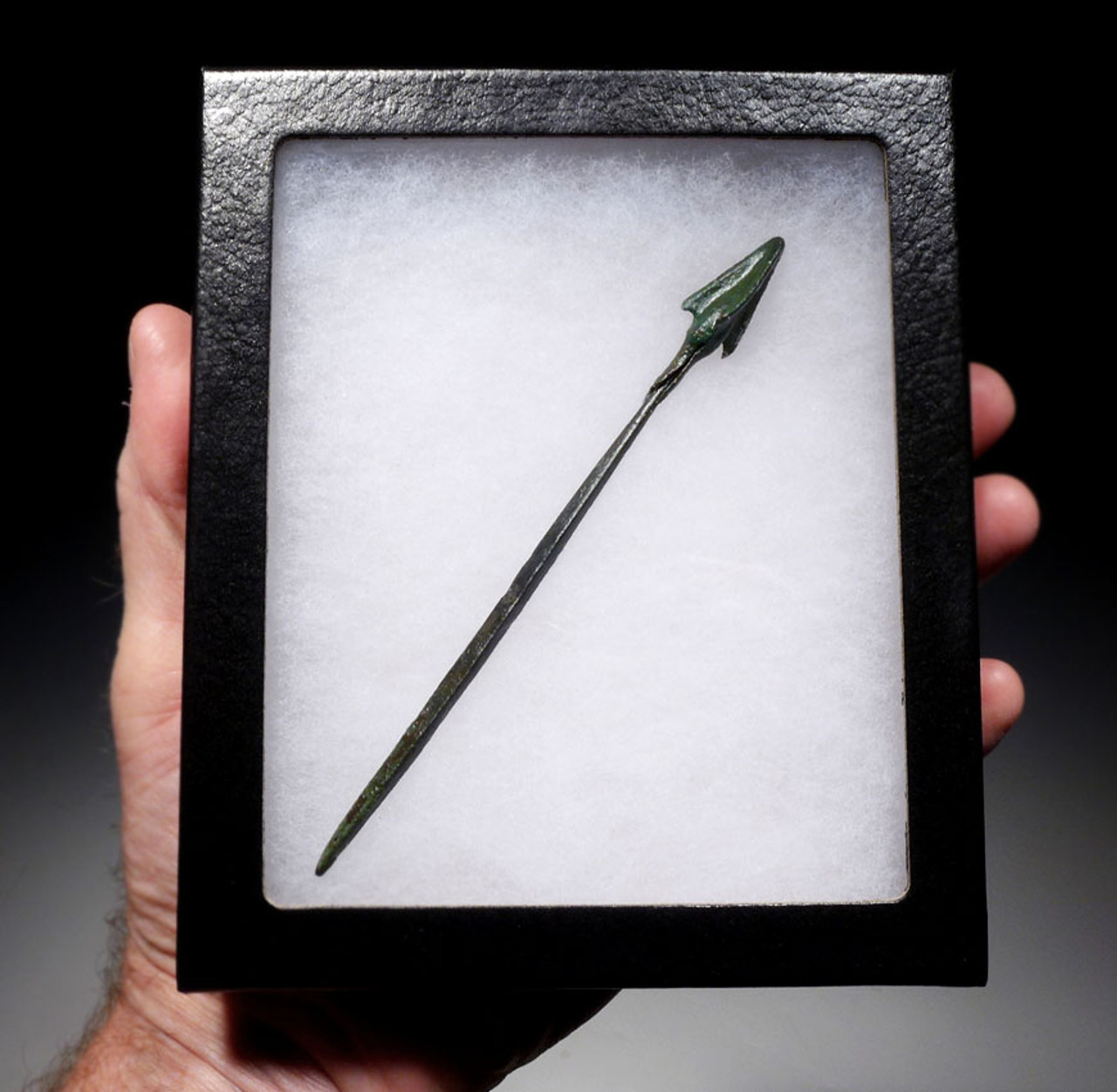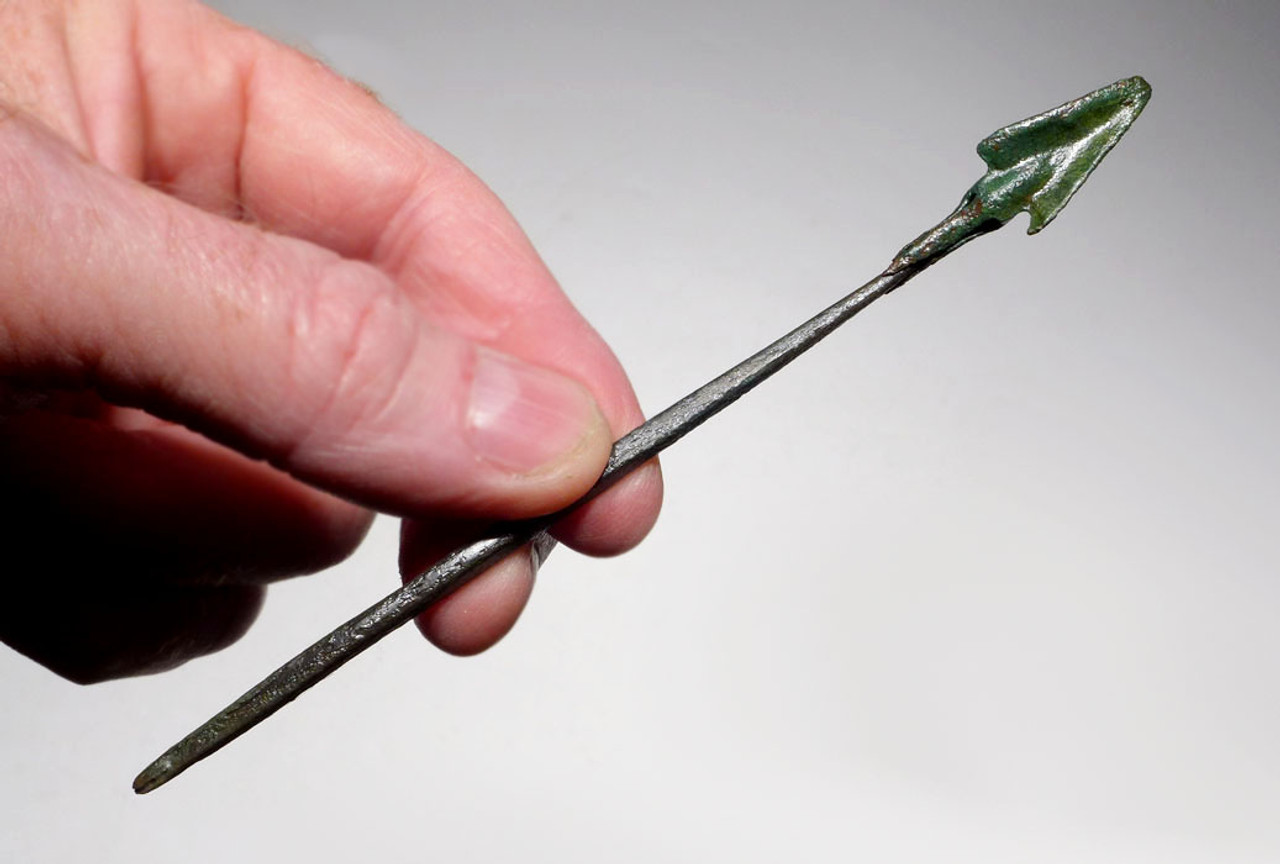Product Description
ID
|
Arrowhead
|
||
FOUND
|
Ancient Near East
|
||
AGE
|
BRONZE AGE: 4000 - 3500 years
|
||
SIZE
|
5.4" long overall
|
||
CONDITION
|
INTACT AND COMPLETE WITH
|
||
NOTE
|
FIRST TIME IN OVER 30 YEARS
|
||
INCLUDES DISPLAY BOX
Comes with a certificate of |
|||
This is an EXTREMELY RARE arrowhead design attributed to the Near Eastern Ancient Iranian Empire. In over 30 years, we have never seen this rare type completely intact. It is an ancient fragmenting tanged arrowhead designed for human combat where when pulled out, the barbed projectile head detached from the tang and remained in the enemy. The quality and preservation condition is of the finest possible level with a full tang, dense bronze metal and an exceptional mineral patina. Deadly effective in combat since smaller points penetrated deeper. NO REPAIR OR RESTORATION.
This artifact has been professionally cleaned and conserved in our lab, being treated with a special sealer developed and formulated by us specifically for ancient metal preservation. The patina shows beautiful traits only found in authentic ancient weapons such as a layered mineralized patina with encrustations. No active bronze disease. Bronze disease can be a problem in bronze artifacts and untreated, it can literally eat away an artifact over a short time of a matter of years and turn the piece to powder.
WARNING: There is an increasing number of fake Near Eastern (Luristan) bronze weapons on the market. As fine quality intact, original specimens become more scarce and techniques have become more sophisticated to fake these weapons. We have personally handled numerous extremely well-done fakes with extremely convincing patinas. The degree to which the fakers have been able to replicate patina to disguise their work requires an expert examination by highly experienced individuals. It is common to find very reasonably priced weapons that are made up of part original and part modern components or wholly modern pieces displaying elaborate artificial patinas. All purchases should include from the dealer a written guarantee of authenticity with unconditional and lifetime return policies regarding such guarantee.
With origins dating back to prehistory, the empire of ancient Iran was one of the world's first superpower civilizations by the time it had taken form in the second millennium B.C.. The various cultures that can be included in the former ancient Iranian Empire stretched across an enormous geographical region extending beyond what is called the Iranian Plateau. To gain insight as to just how large this area was, the Iranian Plateau alone, includes Iran, Afghanistan and Pakistan and comprises approximately nearly 4 million square kilometers (almost 1.5 million square miles). The area of ancient Iran included not only the massive Iranian plateau made up of the tribes of the Medes, Persians, Bactrians and Parthians, but also included groups as far west as the Scythians (an eastern Scythian tribe existed in parallel in Central Asia), Sarmartians, Cimmerians and Alans populating the steppes north of the Black Sea. To the eastern boundary of the empire, the Saka tribes dominated, spreading as far as Xinjiang, China. From a very early period, the ancient Iranian peoples have been historically documented to exist in two separate continuums - a western civilization (Persia) and an eastern civilization (Scythia).
The beginnings of ancient Iran trace back to an influx into the Iranian cultural region of bands of horse-mounted steppe nomads from Central Asia, speaking Indo-European languages. Some settled in eastern Iran but other groups migrated deeper to the west settling in the Zagros Mountains. These first people descended from the proto-Iranians, originating from the Central Asian Bronze age culture of what is called the Bactria-Margiana Complex (aka Oxus Civilization), dated 2200-1700 B.C..
This historical achievements and the breadth of diverse cultures included of this once great empire are too vast to adequately credit in this brief synopsis. The Islamic conquest of Persia in the middle of the 7th century A.D. and the collapse of the Sassanid Empire marked the end of once geographically expansive and culturally diverse ancient superpower.
The term LURISTAN references artifacts made by a society of semi-nomadic people that once lived in the mountainous region of Northwest Iran. Little is known of this ancient culture but the most impressive traces are that of the bronze artifacts they left behind that can be found in parts of present-day Turkey, Iran and Afghanistan. These include highly decorative equipment for their horses, ceremonial containers and numerous weapons ranging from simple utilitarian pieces on up to elaborate masterpieces of warfare.
It is theorized that the Luristan bronzes were crafted by the earliest existence of the Median empire but this has never been proven as written records of the Medes have not survived. The Medes were Indo-Iranian people originally from central Asia who settled in Northwest Iran in the 9th century BC and later defeated the Assyrian empire in 614 BC. Their success is short-lived and their empire which once stretched from central Iran to the Persian Gulf and Anatolia was overrun in 550 BC by the Persians.
 US DOLLAR
US DOLLAR
 EURO
EURO
 AUSTRALIAN DOLLAR
AUSTRALIAN DOLLAR
 CANADIAN DOLLAR
CANADIAN DOLLAR
 POUND STERLING
POUND STERLING










